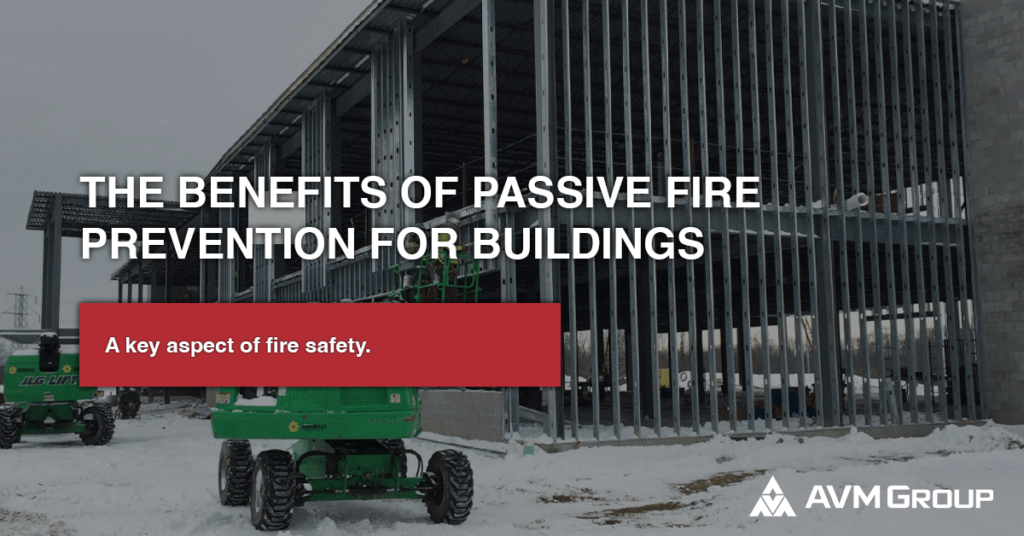*This post is part of a much larger pillar blog: The Complete Commercial Drywall Guide
Table of Contents
ToggleIntroduction
Passive fire prevention measures are an essential aspect of fire safety in commercial buildings.
In this comprehensive guide, we will discuss the key aspects of passive fire prevention in commercial buildings, including building codes and standards, inspections and maintenance, legal requirements, key passive fire prevention measures, and the cost-benefit analysis of implementing these measures.
During this blog, we’ll refer to passive fire prevention occasionally as PFP. Let’s get into it.
Understanding Passive Fire Prevention
What is passive fire prevention? Passive fire prevention aims to limit the spread of fire and smoke without the use of external energy or water sources.
Obviously, this is different from active fire prevention. AFP is characterized by items and/or systems, which require a certain amount of motion and response in order to work, including fire blankets and fire extinguishers.
Passive fire prevention is achieved through the use of fire-resistant materials, fire-retardant coatings, fireproof barriers, and other measures that create a fire-resistant environment in order to prevent fire from starting and spreading into an uncontrollable amount.
Building codes and standards mandate the use of PFP measures in commercial buildings, and failure to comply with these requirements can result in penalties, fines, and even lawsuits, which we’ll discuss later in this blog.
GET THE LATEST INDUSTRY NEWS DELIVERED TO YOUR INBOX
Stay on the forefront of the construction industry with our weekly e-newsletter.
Key Passive Fire Prevention Methods
In this paragraph, we’ll talk in detail about the passive fire prevention methods we’ve mentioned previously.
Fire-resistant materials are arguably the most critical component of PFP in commercial buildings, as it’s what your structure is made of.
These materials can withstand high temperatures and limit the spread of fire and smoke.
Some common fire-resistant materials include concrete, brick, and steel. Like fire-resistant materials, fire-retardant coatings are another important measure that can be applied to wood, fabric, and other nonstructural materials to reduce their flammability.

Fireproof barriers, such as fire-rated walls and doors, can also limit the spread of fire and smoke. Smoke seals, firestop systems, and intumescent paints are additional measures that can prevent the spread of smoke and fire. Fire-rated assemblies, such as fire-rated doors and windows, can provide additional protection.
Another common PFP technique is compartmentalization. Compartmentalization is the practice of dividing a building into smaller sections to limit the spread of fire and smoke.
Best Practices for Passive Fire Prevention in Commercial Buildings
Regular inspections and maintenance are essential to ensure that PFP measures are working effectively. Fire risk assessments can help identify potential hazards and recommend measures to address them.
Building occupants should also be trained to properly use passive fire prevention measures in case of an emergency.
You should have a plan in place before you need it. Coordination with active fire prevention measures, such as sprinkler systems and smoke management systems, is also essential to ensure comprehensive fire safety.

How Passive Fire Prevention and Insurance
Another added benefit to implementing passive fire prevention measures is that it can help reduce insurance costs for commercial building owners.
Who doesn’t like saving money? Insurance companies typically require compliance with building codes and standards, as well as regular inspections and maintenance of PFP measures. Failure to comply with these requirements can result in higher insurance premiums.
Commercial Building Legal Requirements
Building codes and standards mandate the use of PFP measures in commercial buildings.
These requirements vary depending on the type of building, its use, and its location. Failure to comply with these requirements can result in penalties, fines, and even lawsuits.
Conclusion
Passive fire prevention is a critical aspect of fire safety in commercial buildings.
Implementing these measures can help limit the spread of fire and smoke, reduce insurance costs, and comply with legal requirements.
Regular inspections and maintenance, proper training of building occupants, and coordination with active fire prevention measures are essential to ensure comprehensive fire safety.
By following best practices for passive fire prevention, commercial building owners can protect their property and the safety of their occupants. If you want to learn more about commercial construction, check out our blog.
Need help implementing passive fire protection into your building? Contact us.



